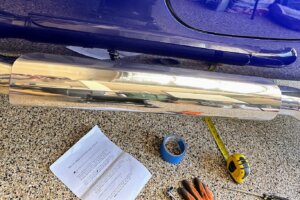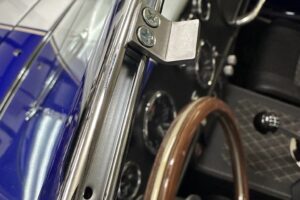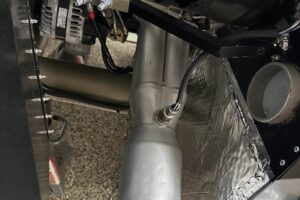It’s been a slow couple of weeks, but I was able to get the radiator aligned and installed onto the chassis. I opted to get the Breeze Automotive Heavy Duty Hinged Radiator/Shroud Mounting Kit, lower radiator support kit and the radiator fan shroud. As usual, these are high quality parts!
First, I had to prep the parts and get them powdercoated. I used nutserts to mount the radiator fan. This removes the need for the FFR nut/bolt scenario. This will make servicing the radiator a bit easier.


I sent parts off to powdercoat, so the next step was to prepare the frame. Determining the mounting points, and drilling a bunch of holes! The 3/4″ tabs on the top rail need to be removed, and then painted to protect. I also installed nutserts in the top rail for easier removal of the radiator if needed. Using the template, I drilled the top of the radiator tab and PC piano hinge to prep for rivets.





Next up was to test fit the radiator, and finish the top hinge. I had to figure out the angle ~51 degrees. I mocked up the radiator panels to get a rough estimate so I can install the lower breeze mount.




Once I had the lower mount holes aligned, it was a simple step-bit on the lower mount braces and I could mount up the lower rail.




Finally, I tightened up the lower mount and now I’m done for now!

I still have lots to do, will probably drill out a ton of sheet metal panels and start using clecos to mount them. I have to run the brake and fuel lines as well – so getting close to having the chassis on the wheels!
Update! I upgraded the FFR fan to a similar sized 16″ Flex-a-lite Flex-Wave LoBoy Electric Fan (Puller) – the benefits of this different fan is lower noise due to the fan blade design, AND more airflow at 3,000cfm at a little less amperage.
I figured it’s good cooling insurance, and much easier to do now than when the body is on, although it was still a PITA to remove the old fan. I had to disassemble the shroud, mounts and the front mesh – then remove the fan and then re-drilled holes for new rivnuts because the spacing is a bit different – then re-assemble!
FFR fan is on the left, the new Flex fan right – see that blade design?



Discover more from Cobra Dreams
Subscribe to get the latest posts sent to your email.







